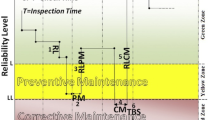Abstract
This paper presents a simulation-based scheduling algorithm for evaluating the performance of different repair policies and computating the optimum size of repair-crews in flexible manufacturing systems. The simulation experiments were conducted for a system with numbers of machines ranging from six to twelve, processing 15 different types of parts. The experiments were planned according to the rules of central composite rotatable experiment design, and the system performance was optimised on the basis of minimum unit production cost. It has been concluded that for the particular system configuration studied, a repair policy based on shortest repair time yields the best results. It has been shown further that the optimum size of repair crews is much more sensitive to labour costs than to other production-associated costs.
Similar content being viewed by others

References
M. Berrada and K. L. Stecke, “A branch and bound approach for machine load balancing in flexible manufacturing systems”,Management Science,32(10), p. 1316, 1986.
J. A. Buzacott and D. D. Yao, “Flexible manufacturing systems: a review of analytical models”,Management Science,32, p. 820, 1986.
W. W. Chan and K. Rathmill, “Digital simulation of a proposed flexible manufacturing system”,Proceedings of the 19th International Machine Tool Design and Research Conference, London, p. 323, 1974.
X. Murotsu, F. Oba, R. Iwata and K. Yasuda, “A production scheduling system for flexible manufacturing systems”, inComputer Application and Engineering, ed. E. A. Warman, North Holland IEIP, 1983.
K. Iwata, Y. Murotsu, F. Oba and K. Yasuda, “Production scheduling of flexible manufacturing systems”,CIRP Annals,31, p. 319, 1982.
W. V. Alven,Reliability Engineering, Prentice-Hall, Englewood Cliffs NJ, 1964.
J. A. Buzacott and S. G. Shanthikumar, “Models for understanding flexible manufacturing systems”,AIIE Transactions,12(4), p. 339, 1980.
D. D. Yao and J. A. Buzacott, “Modelling the performance of flexible manufacturing systems”,International Journal of Production Research,23(5), p. 949, 1985.
P. K. Mishra, P. C. Pandey and C. K. Singh, “Simulation studies of flexible manufacturing systems”,Second International Conference on Simulation in Manufacturing, Chicago, 1986.
W. G. Cochran and G. M. Cox,Experimental Design, Asia Published House, New Delhi, 1962.
K. C. Peng,The Design and Analysis of Scientific Experiments, Addison-Wesley, London, 1967.
N. H. Z. Gindy and V. C. Vasilou, “A case study for the implementation of an FMS for medium size manufacturing employing conventional machinery”,Proceedings of the Fourth Polytechnic Symposium on Manufacturing Engineering, Birmingham, p. 23, 1984.
Author information
Authors and Affiliations
Rights and permissions
About this article
Cite this article
Mishra, P.K., Pandey, P.C. Optimisation of crew size and repair policy in flexible manufacturing systems. Int J Adv Manuf Technol 4, 281–297 (1989). https://doi.org/10.1007/BF02601527
Accepted:
Issue Date:
DOI: https://doi.org/10.1007/BF02601527



